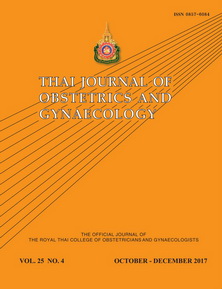Accuracy of Intrapartum Birth Weight Estimation by Clinical Equation in Low Risk Thai Term Pregnant Women
Main Article Content
Abstract
Objectives: To assess the accuracy of clinical equation in estimation of birth weight in Thai term pregnant women and to compare with abdominal palpation method.
Materials and Methods: This cross-sectional study was conducted in 335 term pregnant Thai women who were admitted for delivery at Siriraj Hospital during February 2015 to December 2015. Singleton vertex presented pregnancies were estimated for fetal weight using abdominal palpation and Buchmann, et al. equation [100 x (symphysis-fundal height (cm) - 5)] plus 100 if head engaged. After delivery, the accuracy within ten percent of actual birth weight was calculated and compared between two methods.
Results: Overall accuracy within ten percent of actual birth weight was similar between methods. The accuracy of Buchmann equation and abdominal palpation method were 64.6% and 60.3% (p = 0.218) and the mean absolute percentage errors were 8.7 ± 7.0 and 9.3 ± 6.8 respectively. In the normal birthweight group (2,500-3,999g), Buchmann equation was more accurate than abdominal palpation method (p = 0.045). In detecting macrosomia, abdominal palpation method had higher sensitivity than Buchmann equation, but without statistical significance (83.3% vs. 33.0%; p = 0.079) using 3,500g cut-off value.
Conclusion: Overall accuracy between Buchmann equation and abdominal palpation method was similar. Thus, practitioners who are lack of skills can use Buchmann equation to gain experience. Although Buchmann equation demonstrated better accuracy in the normal birth weight group, it was shown to be less accurate in extreme birthweights. Therefore, other methods for estimation of fetal weight are useful for prediction in extreme groups.
Keywords: Intrapartum birth weight estimation, clinical equation, abdominal palpation, symphysis fundal height
Article Details
References
2 Fuchs F, Bouyer J, Rozenberg P, Senat MV. Adverse maternal outcomes associated with fetal macrosomia: what are the risk factors beyond birthweight? BMC Pregnancy Childbirth 2013;13:90.
3 Jolly MC, Sebire NJ, Harris JP, Regan L, Robinson S. Risk factors for macrosomia and its clinical consequences: a study of 350,311 pregnancies. Eur J Obstet Gynecol Reprod Biol 2003;111:9-14.
4 Hehir MP, O’Connor HD, Higgins S, Robson MS, McAuliffe FM, Boylan PC, et al. Obstetric anal sphincter injury, risk factors and method of delivery - an 8-year analysis across two tertiary referral centers. J Matern Fetal Neonatal Med 2013;26:1514-6.
5 Nkwabong E. Maternal and neonatal complications of macrosomia. Trop Doct 2014;44:201-4.
6 Ugwa EA, Gaya S, Ashimi A. Estimation of fetal weight before delivery in low-resource setting of North-west Nigeria: can we rely on our clinical skills? J Matern Fetal Neonatal Med 2015;28:949-53.
7 Handa VL, Laros RK. Active-phase arrest in labor: predictors of cesarean delivery in a nulliparous population. Obstetrics and gynecology 1993;81:758-63.
8 Buchmann E, Tlale K. A simple clinical formula for predicting fetal weight in labour at term--derivation and validation. S Afr Med J 2009;99:457-60.
9 Curti A, Zanello M, De Maggio I, Moro E, Simonazzi G, Rizzo N, et al. Multivariable evaluation of term birth weight: a comparison between ultrasound biometry and symphysis-fundal height. J Matern Fetal Neonatal Med 2014;27:1328-32.
10 Kayem G, Grange G, Breart G, Goffinet F. Comparison of fundal height measurement and sonographically measured fetal abdominal circumference in the prediction of high and low birth weight at term. Ultrasound Obstet Gynecol 2009;34:566-71.
11 Prechapanich J, Thitadilok W. Comparison of the accuracy of fetal weight estimation using clinical and sonographic methods. J Med Assoc Thai 2004;87:S1-7.
12 Nahum GG, Stanislaw H. Validation of a birth weight prediction equation based on maternal characteristics. J Reprod Med 2002;47:752-60.
13 Nahum GG, Stanislaw H, Huffaker BJ. Accurate prediction of term birth weight from prospectively measurable maternal characteristics. J Reprod Med 1999;44:705-12.
14 Baum JD, Gussman D, Wirth JC, 3rd. Clinical and patient estimation of fetal weight vs. ultrasound estimation. J Reprod Med 2002;47:194-8.
15 Chauhan SP, Hendrix NW, Magann EF, Morrison JC, Kenney SP, Devoe LD. Limitations of clinical and sonographic estimates of birth weight: experience with 1034 parturients. Obstet Gynecol 1998;91:72-7.
16 Chauhan SP, Lutton TC, Bailey KJ, Morrison JC. Intrapartum prediction of birth weight: clinical versus sonographic estimation based on femur length alone. Obstet Gynecol 1993;81:695-7.
17 Noumi G, Collado-Khoury F, Bombard A, Julliard K, Weiner Z. Clinical and sonographic estimation of fetal weight performed during labor by residents. Am J Obstet Gynecol 2005;192:1407-9.
18 Buhmann L, Elder WG, Hendricks B, Rahn K. A comparison of Caucasian and Southeast Asian Hmong uterine fundal height during pregnancy. Acta Obstet Gynecol Scand 1998;77:521-6.
19 Bothner BK, Gulmezoglu AM, Hofmeyr GJ. Symphysis fundus height measurements during labour: a prospective, descriptive study. Afr J Reprod Health 2000;4:48-55.
20 Peregrine E, O’Brien P, Jauniaux E. Clinical and ultrasound estimation of birth weight prior to induction of labor at term. Ultrasound Obstet Gynecol 2007;29:304-9.


